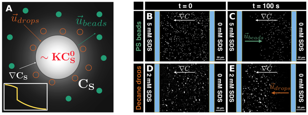Reports: ND554141-ND5: Suspension Interactions via Gradients Generated in situ: Breaking Emulsions and Triggering Flocculation
Todd M. Squires, University of California (Santa Barbara)
Colloidal suspensions and emulsions of 10 − nm to 10 − μm particles play a central role in a wide variety of industrial, technological, biological, and everyday processes. Everyday goods, including shampoos, inks, vaccines, paints, and foodstuffs as well as industrial products such as drilling muds, ceramics, and pesticides, rely fundamentally on stably suspended microparticles for their creation and/or operation. A suite of interactions has long been known and exploited to formulate such suspensions; however, all such interactions act over less than a micron in water - and often much less. The goal of this research project is to design and demonstrate a new and versatile concept that would enable colloidal interactions that are not only long-lived, but also longer-ranged than is currently possible. We believe such interactions will pave the way for new capabilities for manipulating suspensions, sorting particles, and synthesizing novel materials.
Figure 1: (A) Key ingredients required for SI interactions, the beacon (gray), solute and particles (orange, green). (B- E) DP migration of dif- ferent particles under SDS gradients. PS particles move down SDS gradients, whereas decane drops move up them.
These interactions rely predominantly on the fundamental principle of diffusiophoresis (DP), which refers to the migration of suspended particles in response to chemical gradients, in solution. Three ingredients are involved: a soluto-inertial (SI) 'beacon' designed to impart solute-inertia (slow equilibration of the concentration of solute in a material, in response to local changes in the surroundings) and maintain a steady flux of solute over long time scales; suspended particles that migrate in response to the solute flux via DP; and the solute itself, which mediates the interaction (Fig. 1A). The initial objective therefore, was to identify the suitable components for designing these SI interactions in suspensions. Once these ingredients are selected, we can then implement the interactions to control the behavior of particles in suspensions and explore an array of practical applications such as targeted delivery, 'on-demand' destabilization of suspensions.
To demonstrate the core idea of SI interactions, we chose sodium dodecyl-sulfate (SDS) as the solute to mediate the interaction and sulfonated polystyrene (PS) beads and decane droplets as 'test' particles. First, we experimentally demonstrated that under externally imposed SDS gradients, PS particles move down the concentration gradient, whereas droplets of decane move up (Fig. 1B-E). The next step was to choose the beacon itself. SI beacons can be made from materials that strongly partition the solute, so that solute within the beacon (CB) equilibrates at a concentration that exceeds the concentration in the neighboring solution (CS) by a large partition coefficient P, giving CB = PCS, where P≫1. Moreover, whether the beacon attracts or repels colloids in suspension depends on how those colloids migrate under the chosen solute flux.
SDS is known to associate with polyethylene glycol (PEG), suggesting that PEG hydrogels will strongly partition SDS, and thus function as SI beacons. This hypothesis was indeed verified experimentally, where the SI interactions between the PEG hydrogel and the particles were found to not only be particle-surface specific, but last for at least 1,000 s and extend over 300− to 400 − μm (Fig. 2A-B). We also prepared a mathematical model to describe the SI phenomena, where we used simple mass transport arguments to show that the time scale for such SI interactions is directly proportional to the partition coefficient P. Further, the experimentally measured velocities of the colloidal particles, when appropriately scaled according to the SI model, were in excellent agreement with the velocity predicted by the DP theory, first derived by Anderson and Prieve, for electrolyte gradients. The success of the scalings for the SI time and length scale, along with the quantitative agreement between theory and experiment, underscores the quantitative capability to design a long-range, long-lasting suspension interaction. This work was published and highlighted in Proc. Nat. Acad. Sci.
Figure 2: A PEG beacon outfluxing SDS attracts decane drops (A) but repels PS particles (B).













